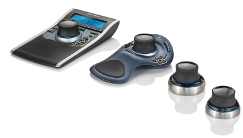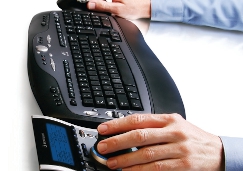3Dconnexion has been part of the fabric of 3D design for many years. Back when there were two products on the market – the SpaceMouse and the SpaceBall, courtesy of LogiCAD3D and Labtec respectively – the CAD world had two similar devices working to similar ends, to provide a hardware based interaction device for navigating 3D. Computing peripheral giant Logitech’s acquisition of the two companies (it had always had an interest in LogiCAD) and integration of them into the 3Dconnexion brand saw the development of the products accelerate. Alongside the professional SpaceExplorer and SpacePilot products, the company launched the more cost effective SpaceNavigator at the end of 2006 to infiltrate the growing consumer level 3D world, where applications such as Second Life and Google Earth were rapidly gaining momentum.
This year the company has been conducting extensive research into how and why people adopt it for 3D design work, what the paybacks are and where the value lies. And with new, undercover products in development, it seemed a good time to visit the SpaceMouse mothership, an hour outside Munich in the sleepy Bavarian town of Seefeld, to speak with Dieter Neujahr, the company’s chairman.

3Dconnexion mouse product range
Al Dean: Where is 3Dconnexion at in terms of adoption in the professional market, particularly mechanical 3D-based design, and how do you plan to push things further? How you get people to see the value in your devices?
Dieter Neujahr: That’s one reason why Logitech formed 3Dconnexion – to find the next big thing in motion control device technology. We still expect the next generation of operating systems to be 3D. Vista, to an extent, already is, as are some flavours of Linux – and it’s also coming on the Mac platform. But so far we are reaching our core market of mechanical CAD. We are in a very good position. For example, our penetration in Germany for professional CAD 3D applications is somewhere between 61 per cent and 79 per cent: roughly two-thirds of 3D mechanical CAD engineers are using a 3Dconnexion 3D mouse.
AD: Nearly 70 per cent of CAD using engineers in Germany are using one of your devices? That’s an incredible statistic.
DN: Pretty much everyone is using one – Volkswagen, Porsche, BMW, Airbus and all the suppliers, at every stage. When I go to tradeshows in Germany and we hit our core market of mechanical CAD engineers or design engineers, of the people that don’t know the product, 20 per cent buy it on the spot. That’s typically the SpaceNavigator. The next 30 per cent are harder to win and the last 25 pe cent we never get. They say, “I’m too old, I’ve been using these tools for 20 years and it’s too much to learn.” In the US we also have a pretty comfortable situation, and we’re penetrating.
So the game is really refreshing the installed base and coming up with new stuff that excites them. Antonio Pascucci, our head of Engineering and Product, is an Italian, but he’s more German than a German. He says, “Quality, quality, quality.” This is certainly an issue, particularly in Germany where we need to refresh product to maintain revenue; the products never stop working, they never break. Each time Antonio brings out a new product, its more durable. We estimate that the lifecycle for each mouse is around five to seven years, and they’re being used after that until people are ready for something new.
AD: I guess it’s an alternative to the Apple philosophy of making nice things, but with short term build quality.
DN: We’re not in the commodity business yet, and our devices are still made for a professional mechanical designer who works multiple hours with our device every day. It’s a pretty sizable market – worldwide its 1.6 million seats and growing, say nine to ten per cent each year. They’re early adopters, the people that go for anything cool, and we want to work with people that live in a 3D world.
We have a big push in adding more and more applications, and that actually needs a lot of software work. Our software development team is three or four times the size of our hardware R&D team, so you might think we’ve a hardware company, but the truth is we’re not. Sometimes we’re lucky and the software vendors integrate our software natively within their application, but in many cases they provide an API and we develop the drivers for their 3D engine. Each time there’s a new revision or upgrade, we have to rewrite the driver. When people look at our driver, which is 80-90Mb, they wonder what the hell we’re doing. It’s a 3D mouse, but for a 130 applications…
It’s actually more than writing drivers, its setting standards because what we want people to have an excellent and superior 3D navigation experience and it needs to be consistent
AD: That’s a lot of different drivers
DN: Yes, it’s a huge amount of work, and we hope that with the proliferation of 3D mice a single driver will be built into the operating system. It’s actually more than writing drivers, its setting standards, because we want people to have an excellent and superior 3D navigation experience and it needs to be consistent. We have an SDK which we give to software developers on the web, or they can buy it (which includes a space navigator). That provides them with the ability to integrate 3D navigation with our devices, and they can do anything with it. This is a concern – if you have someone implement the driver so when you lift the controller cap the model rotates, that’s not what we want, and we don’t certify these applications. You have to have an interest in making the software industry understand that people expect a certain consistent behaviour when using a 3D mouse. That’s something I initially underestimated – it’s a huge communication challenge with the different vendors and software industry.
We used to aim at mechanical engineers using a single application, so consistent navigation in 3D wasn’t an issue. Increasingly, our customers are using multiple applications. If you’re using Catia or SolidWorks, then you want the same consistent method of navigation in Maya or 3dsmax or Cinema 4D. So we see from that information that there’s a trend to multiple complex 3D applications. This brings us to another issue and that’s how to reduce complexity, and that’s why our study was such an eye opener (Ed: available at 3dconnexion.com/productivity).
“Productivity increases” are a nice claim but you need to prove it – which we were able to do. The real eye opener was that 3D mouse users perceive that the quality of their work and their ability to detect errors in their product development processes has gone up tremendously. Not only do they feel more productive, but they do better design work – apart from the side effects of comfort. If you read our white paper, there are more studies where people really tried to quantify reduction in mouse movement and in how much they can reduce hand movement and strain on your hands using a 3D mouse compared to a standard 2D mouse. Engineers usually need to be educated that the left hand is useful for more than a few modifier keys – so you do three or four per cent of work with your left-hand and the rest is with the right. When you use a 3D mouse, it’s balanced across both. Engineers need to have exact navigation and assume there’s a steep learning curve. So our research tried to quantify that.
When you’re in a production environment, there’s nothing worse than being handed something that changes the workflow – it decreases productivity. That’s a huge perception and being able to quantify it was fascinating. Existing users said that they were proficient in using the device and much faster in a shorter space of time.
In Germany our big challenge is refresh and the fact that we make devices that are incredibly durable and well built. How many technology products do people continue to use when they’re seven or even ten years old? Economically, that’s the challenge in Germany but in other markets, including Japan, our penetration is really low and this is where we need to evangelise the concept of 3D navigation.

3Dconnexion Spacepilot
AD: How do you do that with something that breaks your habits as a professional?
DN: The only way is to let people touch it and play with it. In the UK, we use an evaluation programme. When people touch it, it’s sold. Another thing that helps is word of mouth. I compare it with vintage wine, the older the customer gets, the better they become at selling the device for us. The longest standing customers are happier and happier and are more likely to recommend the product to a colleague or a friend. That’s the number one reason people buy the device. Since the launch of SpaceNavigator, we’ve tripled the number we are selling. It brought us to people that thought they couldn’t afford the device or are outside the mechanical CAD market. We see a lot of development with 3D monitors and we’re seeing a huge shift towards 3D. There’s a lot of fantasy in there, but it’s a clear trend.
AD: Why do you think you are the only player in the space?
DN: One reason is that there’s a hell of a lot of work to be done, for hardware and software support. You have to provide great navigation; it has to be immersive, intuitive. There have been a few competitors that have tried button mapping but you get a choppy navigation process. We tried that in the past but it’s a really unpleasant way to navigate. We want to have a smooth, superior, intuitive experience and that’s really difficult to achieve. It took a lot of work to make software vendors understand that the way they train users to navigate in 3D space is bad. They give the users a way to move in 3D with a standard mouse. That isn’t optimal – that’s a huge effort, much more than just button mapping. People have tried it, don’t like it and don’t use it.
Also, it’s still a relatively small market, we’re 15 years into the business and I’ve yet to see devices that are as well thought out as ours, whether its finger driven or the Wiimote – all of these technologies are great, but they lack the controls a professional needs to work in a 3D environment in a relaxed way. It’s important for people to be able to put their hands down. If you want to design in a 3D environment for eight hours a day, pointing fingers…
AD: Then you’re going to be crippled in three days flat. Arms like Popeye, but you’re done. Game over.
DN: Right, it’s not natural. People need to work in a comfortable way. It’s not just the six degrees of freedom and zooming and panning at the same time, it’s about speed control. A little pressure on the sensor, a small movement in 3D; a lot of pressure and you get a lot of movement. On most other devices, you can’t do that. This concept of two-handed navigation with a device that does not move to control your movement in 3D environment is, in my opinion, unsurpassed for what a professional 3D CAD user needs to have today. Especially when you work predominately in 3D. We have a lot of patents around it so we’re well covered.
Frankly, I would love to have a good competitor, a big one, which puts a lot of marketing dollars behind it to evangelise the concept of 3D navigation. Then it comes down to a better product and better marketing and I believe we can win, hands down.
www.3dconnexion.com

Al Dean speaks to 3Dconnexion Chairman Dieter Neujahr about 3D navigation






